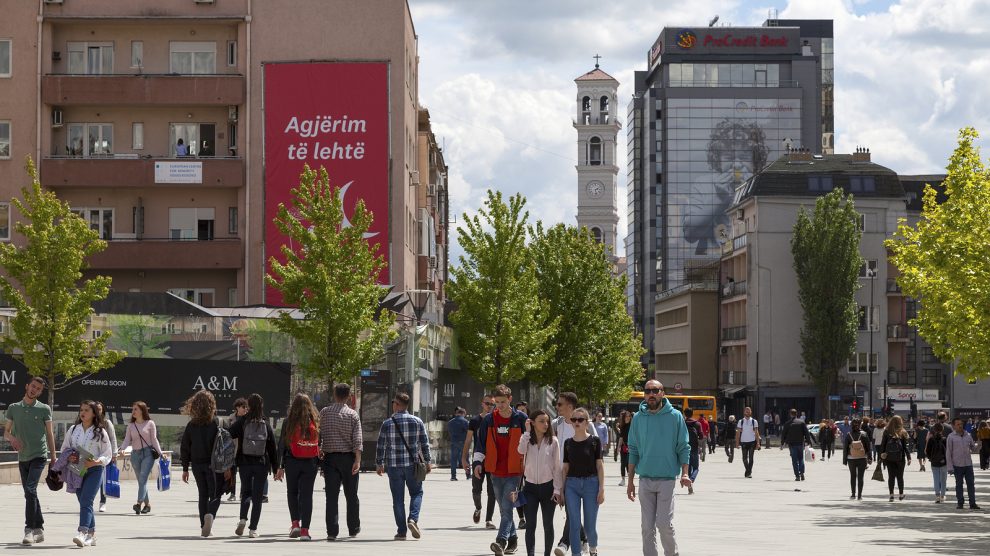Resilient to many of the negative effects of the war in Ukraine, Kosovo’s economy grew in 2022 and is expected to continue to grow through 2023 as exports increase and household consumption stays strong.
By many metrics, Kosovo is one of the less developed economies in emerging Europe.
The poorest region of Yugoslavia, Kosovo suffered from economic isolation and the effects of the Yugoslav wars of the 1990s. Its sovereignty remains highly disputed, with both neighbouring Serbia and five members of the European Union (Cyprus, Greece, Romania, Slovakia, Spain) not recognising its independence—complicating its access to international economic and financial institutions.
Kosovo’s gross domestic product (GDP) per capita in 2022 was a modest 9,170 euros (at purchasing power parity), and World Bank data shows personal remittances made up over 18 per cent of its GDP in 2020 and 2021.
- Western Balkans show resilience despite slowing growth and continued price rises
- EU finally opens its doors to the people of Kosovo
- The EU brokered a deal with Serbia and Kosovo. What’s next?
However, as many economies in emerging Europe stagnated or fell into recession amid skyrocketing energy and commodity prices in the aftermath of Russia’s invasion of Ukraine, Kosovo has proven remarkably resilient.
Kosovo’s GDP grew by 3.5 per cent in 2022, and the Vienna Institute for International Economic Studies (wiiw) expects it to expand another 3.6 per cent in 2023, 3.9 per cent in 2024, and 4.1 per cent in 2025.
While international commodity prices sparked an increase in inflation in 2022, it peaked in January 2023 at 11.9 per cent—significantly lower than in many other countries in emerging Europe, especially the Baltic states—and had fallen to 7.6 per cent in March.
Remittances meanwhile have enabled private consumption to remain strong.
Foreign direct investment (FDI) rose in 2022 by 85 per cent year-on-year, reaching 8.7 per cent of GDP. FDI in January 2023 reached 56 million euros—year-on-year growth of 79 per cent.
Strengths
Kosovo ranked tenth out of 23 countries in Emerging Europe’s 2022 IT Competitiveness Index and fell to eleventh place in the 2023 report.
However, the 2023 report also ranked Kosovo second for IT infrastructure and fifth for economic impact—and first in the cost competitiveness sub-category.
Kosovo experienced an impressive double-digit expansion in service exports in 2022, and Dr Ravik Mima—the author of wiiw’s April forecasts for Kosovo—attributes this largely to IT and call-centre services and visits from the diaspora.
The export of goods also grew as the furniture-manufacturing industry emerged as a major new player even as ferro-nickel production was suspended due to high energy prices.
The Generalised System of Preferences (GSP) is a United States (US) trade programme that provides nonreciprocal, duty- free treatment for approximately 3,500 different products from Kosovo, and mattresses have emerged as a product that has increasingly found a market in the US.
“There has been some level of financial support in the form of subsidies and transfers, which were part of the economic recovery package,” Dr Mima tells Emerging Europe. “This was especially important to offset the impact of the economic downturn and to address the high inflation pressures. The fiscal support reflects the country’s efforts to maintain a stable and robust economic environment.”

Employment and formalisation
Kosovo’s National Tax Agency shows a significant five per cent surge in employment in the first quarter of 2023. The downward trajectory in the unemployment rate may partially be influenced by emigration patterns.
While unemployment in Kosovo has declined over the last several years, wiiw forecasts it will stabilise over the next few.
“The swift economic recovery observed in 2021, characterised by a surge in employment, provides some context for this analysis,” adds Dr Mima. “However, from 2022 onwards, economic activity has adopted a more moderate pace, a trend that is projected to continue into the foreseeable future. This shift may, in part, explain the expected stabilisation in the unemployment rate.”
Employment expansion is likely driven by a progression towards formal employment, catalysed by governmental mitigation strategies during the pandemic rather than the creation of a wealth of new job opportunities. Formalisation was a mandatory condition of the financial support measures rolled out in response to the Covid-19 pandemic.
“Kosovo’s formalisation of the labour market has continued, and this trend is expected to persist,” Dr Mima says. “However, the labour market still faces a high level of inactivity and gender imbalances. Addressing these issues will be crucial for the long-term sustainability of Kosovo’s economic growth.”
As many as 100,000 young Kosovans also remain economically inactive—pursuing neither higher education nor occupational training nor employment.
Activating their potential would close a serious gap in labour participation and would further boost Kosovo’s already resilient economy.
According to the World Bank, Kosovo’s young population needs to be equipped with the skills demanded by a modern economy, and the most vulnerable of its citizens protected by well-targeted and effective social programs.
Gender gaps in access to economic opportunities are another key challenge. Further actions are also needed to promote environmental sustainability, including the fulfilment of the EU’s environmental acquis.
Unlike many news and information platforms, Emerging Europe is free to read, and always will be. There is no paywall here. We are independent, not affiliated with nor representing any political party or business organisation. We want the very best for emerging Europe, nothing more, nothing less. Your support will help us continue to spread the word about this amazing region.
You can contribute here. Thank you.



Add Comment